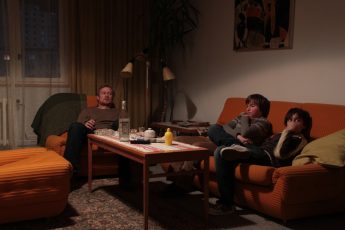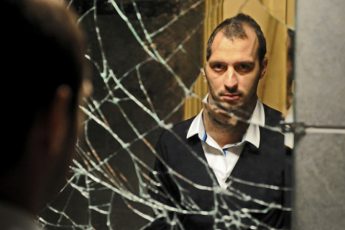Polish Cinema's Identity Crises
Krzysztof Skonieczny’s Hardkor Disko (2014) & al.
Vol. 48 (December 2014) by Moritz Pfeifer
Many contemporary Polish movies about contemporary Polish children/teenagers/young adults are about some form of identity crisis. During the last three or four years alone, we have seen a surprising increase in movies about crisis in religious identity (In the Name of…, Ida), sexual identity (Floating Skyscrapers, Little Crushes), virtual identity (Suicide Room), family identity (Baby Blues, Loving), and cultural identity (Flying Blind). These coming-of-age movies appear to be deeply concerned with the unstable personal development of their characters. Sometimes the difficulty to fit in or to grow into whatever society, class or kinship demands of these fragile youngsters turns out not only psychologically but also physically violent. Houses are burned, babies left to die, people are sexually harassed or commit suicide. But for all the naked brutality, most of these films convey a deep sense of loss. They are more concerned with middle-class ennui (interestingly, economic crisis is the only crisis these characters do not struggle with) than with a society gone bonkers. Accordingly, people are depressed and not desperate, actions are spiritless and not possessed, and violence is drab and not flashy. What these films are really about is the banality of the mundane, deprived desires, alienated egos – in short, good old boredom.
A truism which many people who try to understand works of art subscribe to is that form follows function. What they want to say is that how an artwork looks like is somehow coherent with what it is talking about. For artworks which thematically address boredom, this can turn into a tedious problem since no artwork wants to look boring. But the truism may not hold sway over all themes. Indeed, some writers, like Baudelaire, Chekhov or Beckett for example, have miraculously achieved to make boredom look beautiful, psychologically fascinating or absurd respectively. In cinema, Woody Allen has devoted much of his work to making existential emptiness look endearingly funny, while a bunch of Ingmar Bergman’s films portray it in a more frightening way. I don’t want to say that there are no boring aspects to these authors or filmmakers, but that there’s a difference between presenting an image of boredom and presenting boringly.
As for the Polish films mentioned above, one sometimes wonders whether the directors went through much efforts to keep this distinction alive or whether their films really are indistinguishable from the very boredom, languor, depression, existential emptiness (call it what you may), they try to represent.
Krzysztof Skonieczny’s Hardkor Disko can be seen as a textbook example for this. In it, a young man called Marcin (Marcin Kowalczyk) arrives in Warsaw and infiltrates the lives of a bourgeois family. His target is Ola (Jasmina Polak) with whom he takes drugs, parties, and has meaningless sex. None of this shocks, confuses or alters poor Marcin who dislikes communication and never drops his dispassionate stare. The film’s plot is as unreadable as Marcin’s facial expressions. It is unclear why Marcin chose this family, what drives and angers him. Does it matter? Life is a meaningless, violent party, so this film tells us, just beware who you invite. Indeed, Marcin’s visit is not friendly. He wants to take revenge although it is never clear for what. His violence, the film suggests, is just a reflection of what lurks beneath the boredom of everybody else.
Marcin’s opaqueness, aloofness, and pointless violence makes him look a lot like other characters from contemporary Polish films (think about Eryk Lubos from My Flesh, My Blood, Tomek from Loving, Dominik from Suicide Room or Kuba from Floating Skyscrapers). They communicate through silence. Nobody and nothing can turn them on, cheer them up, make them sad. They are emotionally flat. But while these could be interesting social observations, the films’ formal ingredients are too much inspired by their main characters: murky, cold, and meaninglessly violent. Hardkor Disko neither makes the spectator develop sympathy nor hatred or, in fact, any emotion towards Marcin. Instead of finding a meaningful way to depict the lack of purpose in the lives of the film’s characters, the film stylizes this very purposelessness to the point of scaring away even the most devoted enthusiasts of the form-follows-function paradigm.
There seems to be an awkward self-hating side to these films. To enact the same existential emptiness on cinema as has been perpetrated upon the Polish youth appears to be a peculiar form of self-inflicted punishment. Why these directors do this is difficult to answer. There is, of course, a tradition in European cinema to self-consciously sacrifice so-called entertainment for the purpose of social criticism, and Poland is, by all means, not the only country which produces films whose representations of boredom are also truly boring (the French franchise of home country films pretty much rely on this recipe). So perhaps all this is well–intentioned. Another explanation could be that thinking about the existential emptiness of growing up in terms of identity crisis is a very Western way of looking at the world. This could be the reason why some of these films actually look rather fabricated and fake. Certainly, being homosexual, suicidal, depressed, and so on, are not exceptionally Western phenomena. But thinking that they are individual “problems” is. Indeed, the Polish coming-of-age films mentioned in this article completely ignore the social (or even interpersonal) conditions under which people come to feel that their identity no longer matters. This may be why these films are so redundant. Unable to find explanations for the conditions of their characters outside of the characters themselves, the films invent an indistinct atmosphere of systemic weariness. One may as well believe in God.
Although not exclusively a coming-of-age movie, Ida perhaps best illustrates this kind of individualization of personal suffering. The film is about a young nun, Ida, and the search for her Jewish identity, a religious and cultural identity crisis which the director illustrates by having his main character adopt the familiar behavior of emotionally freezing up. So much so that the question of her Jewish identity is quickly forgotten. We never find out what she thinks about being a Jew, what the Catholics in her nunnery have told her about Jews, what she feels after finding out the truth about her ancestors (it could be anything from denial to traumatic shock). All the complicated ingredients which could feed into her identity crisis are replaced by a vague sense of loss which the director tries to establish through silence and starring as well as a final emotional outburst of drinking, stripping off her coif, and putting on high heels (a rite of passage which many directors of Polish teenagers value as indispensable cinematographic footage). One wonders whether it is possible for Ida to lose her identity at all because she appears to never have had one in the first place. This, by the way, also undermines the well-intentioned effort of the director to give more space to the question of Poland’s Jewish identity. Reducing the absence of Jewish identity in post-WWII Poland to the fuzzy sadness of an individual is a rather bizarre way of depicting hardcore religious discrimination. In the end, the film gives the impression that the indifference of the character conceals the director’s own delayed mourning.
In order to represent someone’s experiences of identity loss as something to be taken seriously, one somehow has to transcend them. Even Andy Warhol’s five-hour-and-twenty-minute recording of his sleeping friend – probably the most boring film ever – somehow avoids being meaningless because the film is not really about his sleeping friend at all. Like all of Warhol’s artworks, it is first and foremost a mirror. It provokes the spectator by asking: how much can you consume? Sadly the Polish directors mentioned in this article appear to believe it is enough to reduce the experience of identity loss to an individual problem. This makes them excruciatingly redundant. When asked why they are sad, many depressed people simply answer that they are sad. This may be because part of being depressed consists in having a hard time thinking outside of one’s self. It ultimately feels right to either copyright one’s own depression or to invent an indistinct thing-in-itself called “sadness” which one may not possess entirely alone but which is also far away from others. As I see it, the identity crisis of Polish cinema consists of being depressed in this sort of way. Instead of confronting, head-on, the demons of their suffering, they seem to have found comfort in finding endless, self-same variations of their existential emptiness without ever even asking “why”. These explanations of “loss” may be interesting for the directors themselves, but they might risk losing the audience on the way.




Leave a Comment